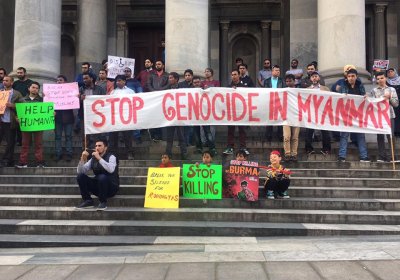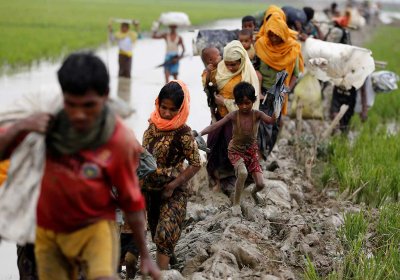Two new documentaries that screened at the recent Sydney Film Festival shine a light, in contrasting but powerful styles, on an important, yet often neglected story in the refugee narrative — why people seek asylum.
Rohingya
The United Nations said that nearly 4000 people have been driven out of their homes in Myanmar (also known as Burma) in April as the country’s north is gripped with violence.
United Nations human rights official Andrew Gilmour said on March 7 that it was impossible to safely send Rohingya refugees in Bangladesh back to their homes in Myanmar as documents released under freedom of information laws show that the Australian defence department plans to spend almost $400,000 on training members of the Myanma military in 2017-18.
More than 600,000 Rohingya have fled Myanmar (also known as Burma) to Bangladesh since August 25. With about 300,000 Rohingya refugees already in Bangladesh, tens of thousands in hiding in northern parts of Rakhine State and about 100,000 detained in Internal Displacement Camps, the United Nations Secretary General Antonio Guterres has described this mass exodus as “the world fastest-developing refugee emergency and a humanitarian and human rights nightmare.”
Tamils and Muslims in Manaar, a town in the north of Sri Lanka, rallied on September 5 in solidarity with the Rohingya people of Myanmar. Hundreds of thousands of Rohingya have been forced to flee Myanmar in recent weeks due to military attacks.
Many Tamils and Muslims see similarities between the situations in Sri Lanka and Myanmar. In both countries, Buddhism is the dominant religion and Buddhist monks have helped incite hatred against religious and ethnic minorities.
More than 500 people attended a rally called by the Islamic Council of Victoria (ICV) on September 9 in solidarity with the Rohingya people of Myanmar (Burma).
Rally chair Adel Salman, the vice-president of the ICV, said genocidal policies against the Rohingya have been carried out for decades. The Rohingya were citizens of Burma when it became independent in 1948, but were deprived of citizenship after a military coup in 1962.
Rohingya are an ethnic Muslim group who have lived for centuries in the majority Buddhist Myanmar.
Many Rohingya came to Myanmar from what is now Bangladesh during the British colonial period (1820s to 1940s) to expand rice cultivation in Rakhine State.
About 1 million Rohingya live in Myanmar, mostly in Rakhine State, making up some 2% of the country’s population and about 30% of the state’s population.
During the early hours of August 25, some 20 to 30 police posts were attacked in Maungdaw, Buthidaung and Rathedaung townships in the north of Rakhine State in Myanmar (also known as Burma). Twelve police were killed along with 16 attackers.
Responsibility for these attacks was later claimed by the Arakan Rohingya Salvation Army (ARSA).
In the two weeks since, the Myanmar military’s response has been brutal, widespread and indiscriminate. While accurate figures are not available, between 400 (military’s estimate), and “around a thousand” (United Nations estimate) Rohingya have been killed by the army.
The ongoing genocide of Rohingya people in western Myanmar (also known as Burma) remains almost ignored by world media. Displaced from their homes, attacked by the military, interned in refugee camps and driven across the border into neighbouring Bangladesh, the Rohingya have become known as one of the world's most persecuted people.
Last year, photographer Ali MC visited Rohingya refugee and internally displaced peoples’ camps in Myanmar and Bangladesh. His aim was to photograph Rohingya people, document their living conditions and better understand the events that forced them into this situation
The victory of Nobel Peace Prize winner Aung San Suu Kyi’s National League for Democracy (NLD) in the November 2015 national elections in Burma (Myanmar) was hailed by Western leaders as heralding a new era of democracy and respect for human rights in the country.
Once isolated by sanctions imposed on the pretext of the widespread human rights abuses by previous military regimes, Burma is now a profitable destination for Western investment. By September, the US had lifted its last remaining sanctions.
Burma: ‘Stop violence against the Rohingya’
The Rohingya are an ethnic group facing extreme persecution in Burma (Myanmar). Australia has been criticised for failing to accept Rohingya asylum seekers as refugees.
The statement below was released on October 18 by 35 groups in Malaysia and the Asian region, including human rights groups and political parties such as the Socialist Party of Malaysia (PSM).
- Page 1
- Next page










